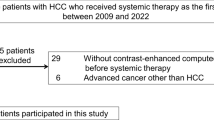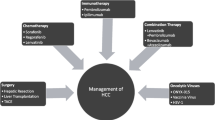Abstract
Objective
To investigate the expression level of serum vascular endothelial growth factor (VEGF) in patients with unresectable hepatocellular carcinoma (HCC) and its relationship with the clinicopathological characteristics, and to assess the impact of serum VEGF as a predictive factor for HCC prognosis during transarterial chemoembolization (TACE) treatments.
Methods
Serum VEGF levels were measured using enzyme-linked immunosorbent assay (ELISA) in 60 random patients who underwent TACE or transarterial infusion (TAI) for unresectable HCC between May and September 2008 and 12 healthy volunteers were also involved in this study to serve as control. All patients’ clinicopathological features were retrospectively analyzed. Serum VEGF levels were correlated with clinicopathological features of the HCC patients. The patients’ survival rates were analyzed with Kaplan-Meier survival curves and compared by the log-rank test. The prognostic significance of serum VEGF levels and factors related to survival rate were evaluated by univariate and multivariate analysis.
Results
The median serum VEGF level in the HCC patients was 285 pg/ml (range 14–1,207 pg/ml), significantly higher than that of healthy controls (P=0.021). The serum VEGF levels were significantly correlated with platelet counts (r=0.396, P=0.002) but not other clinicopathological features. Patients with serum VEGF level >285 pg/ml had worse overall survival compared with those with serum VEGF level <285 pg/ml (P=0.002). By multivariate analysis, the serum VEGF level was a significant prognostic factor.
Conclusion
High serum VEGF levels may predict poor prognosis of HCC after TACE. This study highlights the importance of tumor biomarker as a prognostic predictor in TACE therapy for HCC, which has an intrinsic problem of unavailability of histopathological prognostic features.
Similar content being viewed by others
References
El-Serag HB, Rudolph KL. Hepatocellular carcinoma: Epidemiology and molecular carcinogenesis. Gastroenterology 2007; 132:2557–2576.
Lewandowski RJ, Mulcahy MF, Kulik LM, et al. Chemoembolization for hepatocellular carcinoma: comprehensive imaging and survival analysis in a 172-patient cohort. Radiology 2010; 255:955–965.
Bruix J, Sala M, Llovet JM. Chemoembolization for hepatocellular carcinoma. Gastroenterology 2004; 127(5 Suppl 1):S179–S188.
Bruix J, Sherman M; American Association for the Study of Liver Diseases. Management of hepatocellular carcinoma: an update. Hepatology 2011; 53:1020–1022.
Dzik-Jurasz A. The development and application of functional nuclear magnetic resonance to in vivo therapeutic anticancer research: 2002 Sir Godfrey Hounsfield lecture delivered at the President’s Day, Manchester. Br J Radiol 2004; 77:296–307.
Huang GW, Yang LY, Lu WQ. Expression of hypoxia-inducible factor 1alpha and vascular endothelial growth factor in hepatocellular carcinoma: impact on neovascularization and survival. World J Gastroenterol 2005; 11:1705–1708.
Xiang ZL, Zeng ZC, Fan J, et al. Gene expression profiling of fixed tissues identified hypoxia-inducible factor-1α, VEGF, and matrix metalloproteinase-2 as biomarkers of lymph node metastasis in hepatocellular carcinoma. Clin Cancer Res 2011; 17:5463–5472.
Poon RT, Lau CP, Ho JW, et al. Tissue factor expression correlates with tumor angiogenesis and invasiveness in human hepatocellular carcinoma. Clin Cancer Res 2003; 9:5339–5345.
Karayiannakis AJ, Syrigos KN, Polychronidis A, et al. Circulating VEGF levels in the serum of gastric cancer patients: correlation with pathological variables, patient survival, and tumor surgery. Ann Surg 2002; 236:37–42.
Cooper BC, Ritchie JM, Broghammer CL, et al. Preoperative serum vascular endothelial growth factor levels: significance in ovarian cancer. Clin Cancer Res 2002; 8:3193–3197.
Teknos TN, Cox C, Yoo S, et al. Elevated serum vascular endothelial growth factor and decreased survival in advanced laryngeal carcinoma. Head Neck 2002; 24:1004–1011.
Poon RT, Ho JW, Tong CS, et al. Prognostic significance of serum vascular endothelial growth factor and endostatin in patients with hepatocellular carcinoma. Br J Surg 2004; 91:1354–1360.
Bruix J, Sherman M; Practice Guidelines Committee, American Association for the Study of Liver Diseases. Management of hepatocellular carcinoma. Hepatology 2005; 42:1208–1236.
Llovet JM, Burroughs A, Bruix J. Hepatocellular carcinoma. Lancet 2003; 362:1907–1917.
Senger DR, Galli SJ, Dvorak AM, et al. Tumor cells secrete a vascular permeability factor that promotes accumulation of ascites fluid. Science 1983; 219:983–985.
Smith BD, Smith GL, Carter D, et al. Prognostic significance of vascular endothelial growth factor protein levels in oral and oropharyngeal squamous cell carcinoma. J Clin Oncol 2000; 18:2046–2052.
Byrnes K, White S, Chu Q, et al. High eIF4E, VEGF, and microvessel density in stage I to III breast cancer. Ann Surg 2006; 243:684–690.
Fidler IJ, Yano S, Zhang RD, et al. The seed and soil hypothesis: vascularisation and brain metastases. Lancet Oncol 2002; 3:53–57.
Liu Y, Poon RT, Li Q, et al. Both antiangiogenesis- and angiogenesis-independent effects are responsible for hepatocellular carcinoma growth arrest by tyrosine kinase inhibitor PTK787/ZK222584. Cancer Res 2005; 65:3691–3699.
Zhao J, Hu J, Cai J, et al. Vascular endothelial growth factor expression in serum of patients with hepatocellular carcinoma. Chin Med J 2003; 116:772–776.
Salizzoni M, Romagnoli R, Lupo F, et al. Microscopic vascular invasion detected by anti-CD34 immunohistochemistry as a predictor of recurrence of hepatocellular carcinoma after liver transplantation. Transplantation 2003; 76:844–848.
Jonas S, Bechstein WO, Steinmüller T, et al. Vascular invasion and histopathologic grading determine outcome after liver trans-plantation for hepatocellular carcinoma in cirrhosis. Hepatology 2001; 33:1080–1086.
Huo TI, Wu JC, Hsia CY, et al. Hepatitis C virus infection is a risk factor for tumor recurrence after resection of small hepatocellular carcinomas. World J Surg 2004; 28:787–791.
Pang R, Poon RT. Angiogenesis and antiangiogenic therapy in hepatocellular carcinoma. Cancer Lett 2006; 242:151–167.
Gupta MK, Qin RY. Mechanism and its regulation of tumor-induced angiogenesis. World J Gastroenterol 2003; 9:1144–1155.
Miraglia R, Pietrosi G, Maruzzelli L, et al. Efficacy of transcatheter embolization/chemoembolization (TAE/TACE) for the treatment of single hepatocellular carcinoma. World J Gastroenterol 2007; 13:2952–2955.
Sergio A, Cristofori C, Cardin R, et al. Transcatheter arterial chemoembolization (TACE) in hepatocellular carcinoma (HCC): the role of angiogenesis and invasiveness. Am J Gastroenterol 2008; 103:914–921.
Poon RT, Lau CP, Cheung ST, et al. Quantitative correlation of serum levels and tumor expression of vascular endothelial growth factor in patients with hepatocellular carcinoma. Cancer Res 2003; 63:3121–3126.
Poon RT, Lau C, Yu WC, et al. High serum levels of vascular endothelial growth factor predict poor response to transarterial chemo-embolization in hepatocellular carcinoma: a prospective study. Oncol Rep 2004; 11:1077–1084.
Li X, Feng GS, Zheng CS, et al. Expression of plasma vascular endothelial growth factor in patients with hepatocellular carcinoma and effect of transcatheter arterial chemoembolization therapy on plasma vascular endothelial growth factor level. World J Gastroenterol 2004; 10:2878–2882.
George ML, Eccles SA, Tutton MG, et al. Correlation of plasma and serum vascular endothelial growth factor levels with platelet count in colorectal cancer: clinical evidence of platelet scavenging? Clin Cancer Res 2000; 6:3147–3152.
Li B, Sharpe EE, Maupin AB, et al. VEGF and PlGF promote adult vasculogenesis by enhancing EPC recruitment and vessel formation at the site of tumor neovascularization. FASEB J 2006; 20:1495–1497.
Moore MA, Hattori K, Heissig B, et al. Mobilization of endothelial and hematopoietic stem and progenitor cells by adenovector-mediated elevation of serum levels of SDF-1, VEGF, and angiopoietin-1. Ann N Y Acad Sci 2001; 938:36–47.
Lencioni R, Cioni D, Crocetti L, et al. Early-stage hepatocellular carcinoma in patients with cirrhosis: long-term results of percutaneous image-guided radiofrequency ablation. Radiology 2005; 234:961–967.
Xu HX, Lu MD, Xie XY, et al. Prognostic factors for long-term outcome after percutaneous thermal ablation for hepatocellular carcinoma: a survival analysis of 137 consecutive patients. Clin Radiol 2005; 60:1018–1025.
Berber E, Rogers S, Siperstein A. Predictors of survival after laparoscopic radiofrequency thermal ablation of hepatocellular cancer: a prospective study. Surg Endosc 2005; 19:710–714.
Chung IK, Park MJ, Kwon KT, et al. The factors related to the prognosis of solitary hepatocellular carcinoma after radiofrequency ablation. Korean J Hepatol 2005; 11:371–380.
Gasparini G, Longo R, Toi M, et al. Angiogenic inhibitors: a new therapeutic strategy in oncology. Nat Clin Pract Oncol 2005; 2:562–577.
Zhu AX, Blaszkowsky LS, Ryan DP, et al. Phase II study of gemcitabine and oxaliplatin in combination with bevacizumab in patients with advanced hepatocellular carcinoma. J Clin Oncol 2006; 24:1898–1903.
Author information
Authors and Affiliations
Corresponding author
Additional information
This work was supported by National Science & Technology Major Project of China (No. 2008ZX10002-026).
Rights and permissions
About this article
Cite this article
Guo, Jh., Zhu, X., Li, Xt. et al. Impact of serum vascular endothelial growth factor on prognosis in patients with unresectable hepatocellular carcinoma after transarterial chemoembolization. Chin. J. Cancer Res. 24, 36–43 (2012). https://doi.org/10.1007/s11670-012-0036-8
Received:
Accepted:
Published:
Issue Date:
DOI: https://doi.org/10.1007/s11670-012-0036-8




